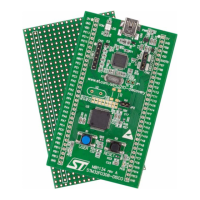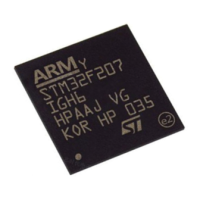Ethernet (ETH): media access control (MAC) with DMA controller RM0008
964/1096 Doc ID 13902 Rev 12
Meanwhile, if another Pause frame is detected with a zero Pause time value, the MAC
resets the Pause time and manages this new pause request.
If the received control frame matches neither the type field (0x8808), the opcode (0x00001),
nor the byte length (64 bytes), or if there is a CRC error, the MAC does not generate a
Pause.
In the case of a pause frame with a multicast destination address, the MAC filters the frame
based on the address match.
For a pause frame with a unicast destination address, the MAC filtering depends on whether
the DA matched the contents of the MAC address 0 register and whether the UPDF bit in
ETH_MACFCR is set (detecting a pause frame even with a unicast destination address).
The PCF register bits (bits [7:6] in ETH_MACFFR) control filtering for control frames in
addition to address filtering.
Receive operation multiframe handling
Since the status is available immediately following the data, the FIFO is capable of storing
any number of frames into it, as long as it is not full.
Error handling
If the Rx FIFO is full before it receives the EOF data from the MAC, an overflow is declared
and the whole frame is dropped, and the overflow counter in the (ETH_DMAMFBOCR
register) is incremented. The status indicates a partial frame due to overflow. The Rx FIFO
can filter error and undersized frames, if enabled (using the FEF and FUGF bits in
ETH_DMAOMR).
If the Receive FIFO is configured to operate in Store-and-forward mode, all error frames can
be filtered and dropped.
In Cut-through mode, if a frame's status and length are available when that frame's SOF is
read from the Rx FIFO, then the complete erroneous frame can be dropped. The DMA can
flush the error frame being read from the FIFO, by enabling the receive frame flash bit. The
data transfer to the application (DMA) is then stopped and the rest of the frame is internally
read and dropped. The next frame transfer can then be started, if available.
Receive status word
At the end of the Ethernet frame reception, the MAC outputs the receive status to the
application (DMA). The detailed description of the receive status is the same as for
bits[31:0] in RDES0, given in RDES0: Receive descriptor Word0 on page 995.
Frame length interface
In case of switch applications, data transmission and reception between the application and
MAC happen as complete frame transfers. The application layer should be aware of the
length of the frames received from the ingress port in order to transfer the frame to the
egress port. The MAC core provides the frame length of each received frame inside the
status at the end of each frame reception.
Note: A frame length value of 0 is given for partial frames written into the Rx FIFO due to overflow.
MII/RMII receive bit order
Each nibble is transmitted to the MII from the dibit received from the RMII in the nibble
transmission order shown in Figure 341. The lower-order bits (D0 and D1) are received first,
followed by the higher-order bits (D2 and D3).

